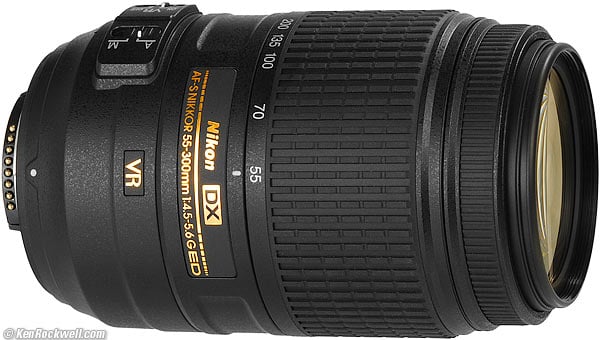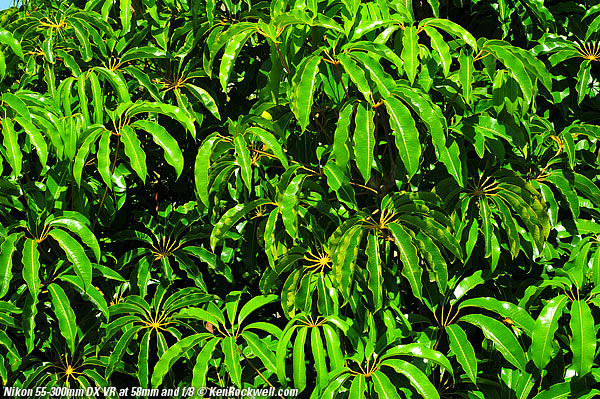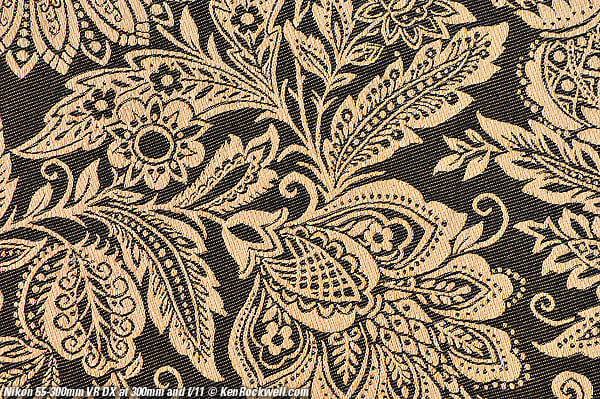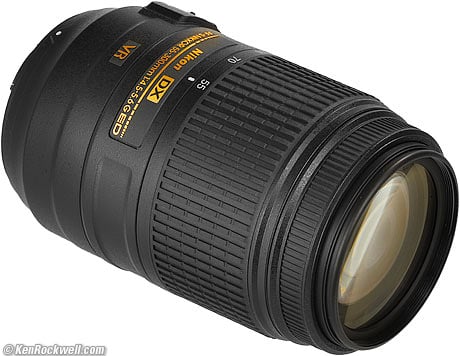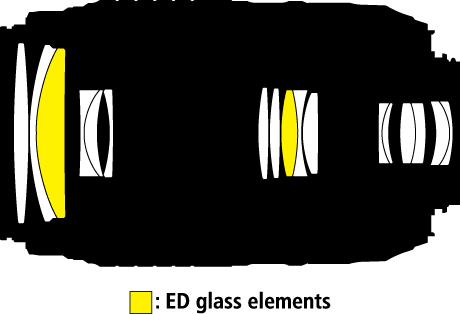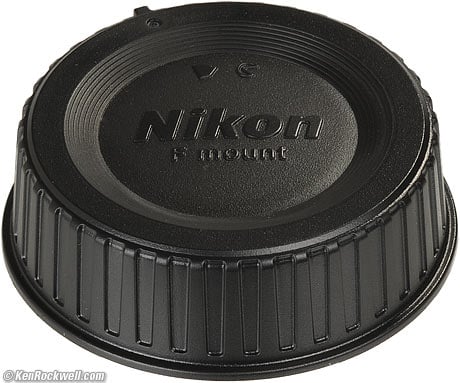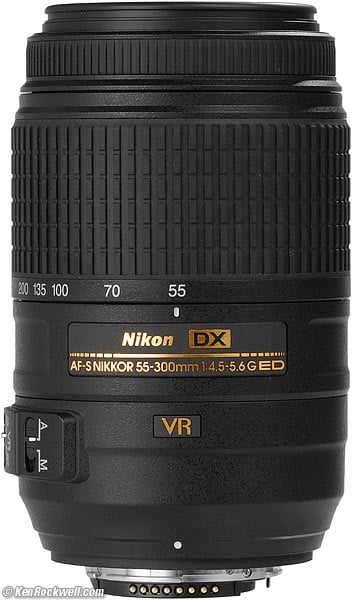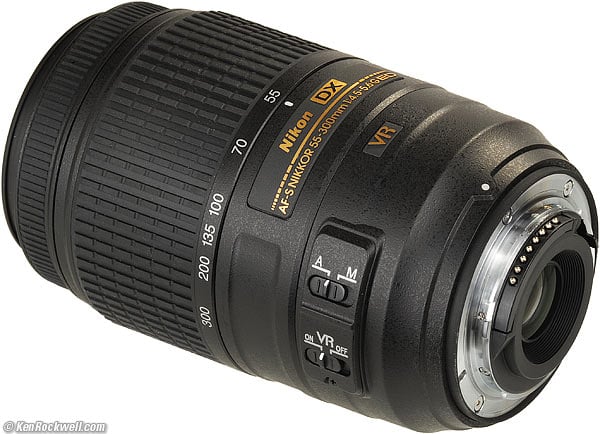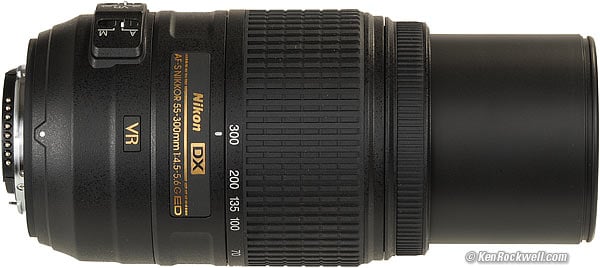Home Donate New Search Gallery How-To Books Links Workshops About Contact
Nikon 55-300mm VR
DX only, $399 (2010-)
© 2010-2013 KenRockwell.com. All rights reserved.
Intro Specs Performance Usage Compared Recommendations
Nikon 55-300mm f/4.5-5.6 VR DX (DX cameras only, 58mm filters, 18.6 oz. (529g), 4.6'/1.4m close-focus). enlarge. If you find this page useful and would like to help support my work here, the biggest help is when you use these links, especially this link directly to this 55-300mm lens at Adorama and at Amazon when you get anything, regardless of the country in which you live. Thank you! Ken.
Deal: Sometimes these are available refurbished, which are always a great buy.
May 2013 Nikon Reviews Nikon Lenses All Reviews
Ideal for: Perfect normal and long-telephoto lens for general photography, but only on DX digital cameras.
Not for: Film or FX digital cameras. Slow autofocus and needing to move a switch to get to and from manual focus makes the 55-300mm poor for moving subjects; use the 70-300mm VR instead for fast action, as well as for film and FX.
Sample image at 58mm and f/8. original file.
Sample image at 300mm and f/8. original file (subject is tilted, watch focus).
Introduction top
Intro Specs Performance Usage Compared Recommendations
|
I personally suggest Adorama, Amazon, Ritz, B&H, Calumet and J&R. I can't vouch for ads below.
|
This Nikon 55-300mm VR lens is a reasonably priced, small, lightweight and very high-powered telephoto zoom for any DX camera.
It's an ideal lens for anyone not expecting to upgrade to FX, and who needs a little more reach than the excellent 55-200mm VR.
The optical performance of this 55-300mm lens is excellent.
Autofocus is slow. If you want to shoot action, pay a little more for the larger and more expensive semi-professional FX 70-300mm VR instead.
To get to and from manual focus mode, you must move a switch on this 55-300mm. There is no instant override as there is on the 70-300mm VR. Manual focus doesn't work very well on this 55-300mm anyway, so if you want easy access to manual focus (I do), opt for the 70-300mm VR instead.
If you don't really need 300mm, the 55-200mm VR is the same as this 55-300mm lens, except for the plastic mount and 200mm maximum, for half the price.
This 55-300mm excels for use as an ultra-compact, reasonably-priced supertelephoto, so long as you're not getting it for sports. For sports, you want the 70-300mm VR, but for general use, heck, I can read a licence plate at a quarter-mile (400 meters) in my images!
This Nikon 55-300mm lens works only with Nikon's DX digital cameras.
It will attach to FX and film cameras, but will not fill the complete FX image.
See Nikon Lens Compatibility for details with your camera. Read down the ", AF-I," "G" and "VR" columns for this lens. You'll get the least of all the features displayed in all columns, since "G" (gelding) is a handicap which removes features.
Nikon 55-300mm. enlarge.
Specifications top
Intro Specs Performance Usage Compared Recommendations
Name top
Nikon calls this the Nikon DX AF-S NIKKOR 55-300mm f/4.5-5.6G ED VR. Whew!
DX: Won't work on film or FX cameras.
AF-S and SWM: Silent Wave Autofocus Motor.
G: Gelded for cost-reduction and removing compatibility with older cameras.
ED: Magic Extra-low Dispersion Glass.
VR: Vibration Reduction.
Optics top
Internal diagram, Nikon 55-300mm. enlarge.
17 elements in 11 groups.
Two of these are ED, and one is called "HRI," high refractive index.
HRI glass has an index of refraction even greater then 2. ED glass has always had low refractive indices, and glass with higher indices of refraction has been what's been letting lens makers shrink lenses for decades ad higher and higher indices of refraction are created.
Maximum Aperture top
f/4.5-5.6. details.
Diaphragm top
9 rounded blades.
Stops down to f/22-29.
Reasonably circular opening at all apertures, except the very smallest.
Coverage top
DX only; cannot cover film or FX.
Focal Length top
55-300mm, which on a DX camera gives angles of view similar to what an 80-450mm lens sees when used on an FX or 35mm camera.
Angle of View top
28° 50' ~ 5° 20' on DX.
Close Focus top
4.6 feet (1.4m).
Maximum Reproduction Ratio top
1:3.6.
Focus Scale top
No.
Depth-of-Field Scale top
No.
Infra-Red Focus Index top
No.
Aperture Ring top
No.
Tripod Collar top
No.
Filter Thread top
58mm, plastic.
Rotates with focus, but not with zoom.
Vibration Reduction (VR) top
VR II system.
Claims "up to 4 stops" improvement.
Nikon's sales literature claims it recognizes when it's attached to a tripod, yet the instructions suggest turning off VR when on a tripod. I don't worry about it either way.
Size top
Nikon specifies 4.8" (123mm) extension from flange by 3.0 " (76.5mm) diameter.
Weight top
18.647 oz. (528.6g), measured.
Nikon specifies 18.7 oz. (530g).
Hood top
Plastic bayonet hood HB-57, included.
Case top
CL-1020 pouch, included.
Included top
58mm LC-58 snap-on front cap.
Plastic bayonet hood HB-57.
CL-1020 pouch.
LF-4 rear cap, which is a new part number.
New LF-4 Rear Cap. enlarge.
Announced top
19 August 2010.
Available top
Shipping since September 2010.
Nikon Product Number top
2197.
Quality top
Lens: Made in People's Republic of China.
LR-4 rear cap: Made in Thailand.
LC-58 front cap: Made in Thailand.
Warranty top
5 years, USA.
Price, USA top
2012 June: $399; $299 refurbished.
2010 October: $389.
2010 August: $399.95.
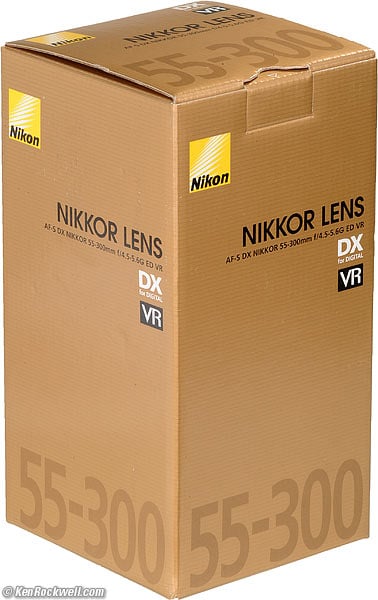
Box, Nikon 55-300 DX VR.
Performance top
Intro Specs Performance Usage Compared Recommendations
Overall Focus Bokeh Color Distortion Ergonomics
Eyeblow Falloff Filters Focal Lengths, effective
Lateral Color Fringes Macro Maximum Aperture
Mechanics Sharpness Sunstars Survivability VR Zooming
Overall performance top
The Nikon 55-300mm VR DX is a perfectly competent, light-weight, wide-range telephoto for DX cameras.
It's better than the smaller and lighter 55-200mm VR, with which this 55-300mm VR has much in common. The 70-300mm VR is a much bigger, better and not that much more expensive FX lens.
Focus performance top
AF Speed
Autofocus is slow.
At 300mm, if you're way out of focus, you may have to try a couple of times to get the camera to wake up and focus. This is because you can get so far out of focus at 300mm that the camera has no idea what's going on, since the image becomes just one big blur. If this is a problem, focus on something else halfway to your intended subject to get the camera sort of in focus, and then it ought to focus the rest of the way to the subject next time you hit the shutter. This isn't a lens issue as much as an issue with all supertelephoto AF lenses.
AF Accuracy
AF always seems to be right-on, which is easy for a lens this slow.
Manual Focus
Manual focus is crummy.
First, you have to move a switch on the lens, and then the manual focus is sort of a joke. It moves too fast for precise focus at the longer focal lengths where you need it, and almost OK at the short end, where you don't.
For excellent manual focus, forget this lens and step up to the 70-300mm VR instead.
Bokeh performance top
Tree at 10 meters (30'); 55-300mm VR DX at 300mm and f/5.6. bigger.
Bokeh, the character of out of focus backgrounds, not simply how far out of focus they are, is beautiful. Backgrounds stay soft, and not bothersome.
If you need a narrow depth-of-field, remember that it is narrowest at 300mm.
Color Rendition performance top
The color rendition of this 55-300mm matches all my other modern NIKKOR lenses.
Distortion performance top
The Nikon 55-300mm VR DX has little distortion on the ends of the zoom range, but strong pincushion around 135-200mm
This can be corrected easily by plugging these figures into Photoshop's lens distortion filter. These aren't facts or specifications, they are the results of my research that requires hours of photography and calculations on the resulting data.
|
|
Visible Effects on DX at 10' (3m) |
|
55mm |
very mild barrel distortion |
+1.5 |
70mm |
none |
-1.0 |
100mm |
moderate pincushion distortion |
-2.3 |
135mm |
strong pincushion distortion |
-3.0 |
200mm |
strong pincushion distortion |
-3.0 |
300mm |
moderate pincushion distortion |
-2.0 |
© 2010 KenRockwell.com. All rights reserved.
Ergonomics (handling and ease-of-use) performance top
Nikon 55-300mm VR DX . enlarge.
Ergonomics are great, if all you want to do is zoom in and out. The zoom ring is big and easy to handle.
If you want manual focus, it's awful.
It's a pain to have to slide the A - M switch back and forth to get to and from manual mode, and once you're there, manual focus is geared entirely too fast. It focuses from one extreme to the next in a quick 60º of rotation, making it almost impossible to focus precisely manually.
Eyeblow performance top
As the 55-300mm VR DX is zoomed in and out, air pumps in and out, and you may have some air blow out of the eyepiece into your eye.
You won't usually care, but the design of the 55-300 VR is such that air, and thus dirt, are pumped in and out all the time into both your lens and your camera.
Falloff (darkened corners) performance top
Falloff isn't visible.
I've exaggerated this by shooting a gray field and placing these on a gray background.
Nikon 55-300mm VR DX falloff at infinity, no correction.
© 2010 KenRockwell.com. All rights reserved.
|
Filters, use with performance top
Like most telephotos, there is no problem with vignetting.
Except at 300mm, feel free to stack as many filters as you like.
The plastic filter threads rotate with focus, but not with zooming.
Focal Lengths, effective performance top
Even though Nikon cautions that the effective focal length shortens as one focuses more closely, I don't see any shrinkage. 300mm looks like 300mm, even at 4.6 feet (1.4 meters).
By comparison, the 28-300mm VR is nowhere near 300mm at its 300mm setting at 5 feet.
This 55-300mm lens shows the same tight image at 4.6 feet as the 28-300mm shows at 1.5 feet!
Lateral Color Fringes performance top
A D300 corrects for these automatically, thus I see none on a D300, except at 300mm on the sides, where there can be a tiny bit of lateral color.
Macro performance top
With a rated maximum reproduction ratio of 1:3.6, that means you can fill the frame with something as small as 2-1/4 x 3-1/3 inches (55 x 85mm), from 4.6 feet (1.4 meters) away!
Maximum and Minimum Apertures Performance top
Maximum |
Minimum |
|
55mm |
f/4.5 |
f/22 |
70mm |
f/4.5 |
f/22 |
100mm |
f/4.8 |
f/23 |
135mm |
f/4.8 |
f/25 |
200mm |
f/5 |
f/25 |
300mm |
f/5.6 |
f/29 |
Mechanics and Construction performance top
Nikon 55-300mm VR DX . enlarge.
The Nikon 55-300mm VR DX feels almost as nice as Nikon's serious amateur lenses like the 28-300mm VR and 16-35mm VR. Except for the dinky manual focus and plasticy extending barrels, it feels pretty nice.
Filter Threads
Plastic.
Hood
Plastic bayonet.
Hood Mount
Plastic.
Barrel Exterior
Plastic.
Focus Ring
Rubber covered plastic.
Zoom Ring
Rubber covered plastic.
Depth-of-Field Scale
None.
Internals
Plastic.
Aperture Ring
None.
Mount
Dull-chromed brass.
Markings
Paint.
Identity Plate
Debossed plastic plate that looks like metal.
Serial Number
Sticker glued into a recess in the bottom rear of barrel, near mount.
Ass-Gasket (dust seal at mount)
Yes.
Noises When Shaken
Mild clicking.
Made in
Sharpness performance top
Warning 1: Image sharpness depends more on you than your lens.
Warning 2: Lens sharpness doesn't mean much to good photographers.
With those caveats, the Nikon 55-300mm VR DX is sharp!
Except for the sides at 300mm at f/5.6, everything is sharp everywhere.
More under Comparisons.
Nikon's claimed MTF curves.
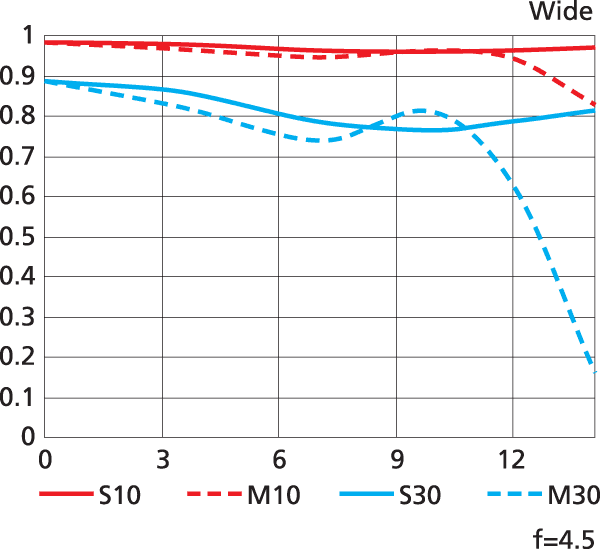 MTF, 55mm.
MTF, 55mm.
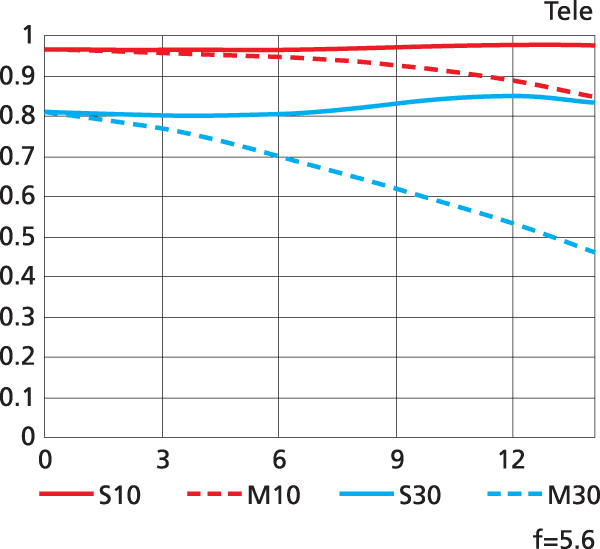 MTF, 300mm.
MTF, 300mm.
Sunstars performance top
With its almost always circular diaphragm, I couldn't get any sunstars on bright points of light.
Survivability performance top
As with all consumer zooms that pump in and out, never bang the front of the lens because it will be easy to break the internal plastic zoom mechanism.
VR performance top
I didn't test it numerically, but vibration reduction (VR) appears to work great.
It's easy to get sharp hand-held shots at 300mm.
Without VR, it's usually impossible to get sharp hand-held shots with lenses this small and light, and with this much magnification.
VR is critical in a lens like this, and it works great.
Zooming performance top
Nikon 55-300mm at 300mm. enlarge.
Zooming is well spaced. Its easy to set precise compositions, and to zoom quickly.
It's a little tighter between 200mm and 300mm, but not enough to worry about.
Zooming is a bit on the firm side. It never flops or creeps.
Usage top
Intro Specs Performance Usage Compared Recommendations
Turn off VR when on a tripod.
When using VR, it may take a second for the image to stop wiggling when you first tap the shutter. Be sure to wait that second if you're at the 300mm end to ensure the sharpest images.
Compared performance top
Intro Specs Performance Usage Compared Recommendations
Sharpness
I shot the 55-300mm VR against the 70-300mm VR, 75-300mm AF and 28-300mm VR, on a 12 MP DX D300.
At 70mm at infinity, all were as sharp in the center, but the 28-300mm was softest on the sides of DX wide-open at 70mm. The differences were gone by f/8.
At 135mm at infinity, they were the same in the center, with the 75-300mm AF and 28-300 VR only a little softer on the sides wide-open.
All were about the same in the center at 300mm at infinity. At 300mm on the left of the image, the 55-300mm DX VR and 75-300mm AF were the softest. On the right side, the 28-300mm VR was the softest. Thus, since the 70-300mm VR never got soft of either side, it wins.
In the real world, even professional zooms like the 200-400mm f/4 are often sharper or softer on one side or the other.
Don't worry about it; this is a sharp lens, as sharp as the rest. You have to pay more for mechanical longevity and instant access to manual focus, not for optical quality today.
AF Speed
AF is slow on the 55-300mm VR DX and 75-300mm AF, and fast on the 70-300mm VR and 28-300mm VR.
55-300mm VR |
|||
| Works on FX or film? | no |
no |
Yes |
| Instant manual-focus override? | no |
no |
Yes |
| Diaphragm | 9 |
7 |
9 |
| FIlter | 58mm |
52mm |
67mm |
| Weight | 530g |
335g |
745g |
| Price, 8/2010 |
Recommendations top
Intro Specs Performance Usage Compared Recommendations
I covered this in the Introduction.
This is a swell lens, but really not much tougher or more useful than the much less expensive 55-200mm VR. Autofocus is slow in both these Chinese lenses, and will be frustrating for action shots.
As of October 2010, Nikon's 70-300mm VR isn't much more expensive, and is a far superior lens which focuses almost instantly, and offers almost instant manual focus override.
If you want this 55-300mm VR and don't mind slower AF and clumsy manual focus, its optics and VR system are superb.
Deployment
I'd leave either a 58mm Nikon Clear (NC - UV) filter, or a 58mm Hoya Super HMC UV on the lens at all times. I would leave the hood at home.
If I was working in nasty, dirty areas, I'd forget the cap, and use an uncoated 58mm Tiffen UV filter instead. Uncoated filters are much easier to clean, but more prone to ghosting.
More Information
Nikon, Australia's press release
Help me help you top
I support my growing family through this website, as crazy as it might seem.
The biggest help is when you use any of these links when you get anything, regardless of the country in which you live. It costs you nothing, and is this site's, and thus my family's, biggest source of support. These places have the best prices and service, which is why I've used them since before this website existed. I recommend them all personally.
If you find this page as helpful as a book you might have had to buy or a workshop you may have had to take, feel free to help me continue helping everyone.
If you've gotten your gear through one of my links or helped otherwise, you're family. It's great people like you who allow me to keep adding to this site full-time. Thanks!
If you haven't helped yet, please do, and consider helping me with a gift of $5.00.
As this page is copyrighted and formally registered, it is unlawful to make copies, especially in the form of printouts for personal use. If you wish to make a printout for personal use, you are granted one-time permission only if you PayPal me $5.00 per printout or part thereof. Thank you!
Thanks for reading!
Mr. & Mrs. Ken Rockwell, Ryan and Katie.
Home Donate New Search Gallery Reviews How-To Books Links Workshops About Contact

